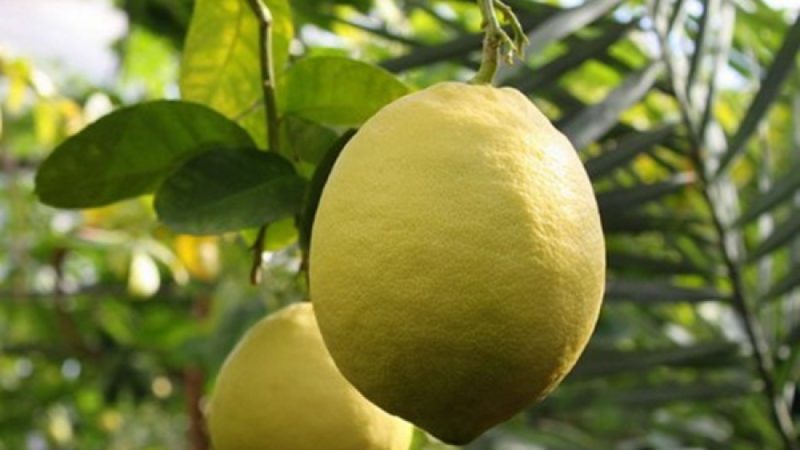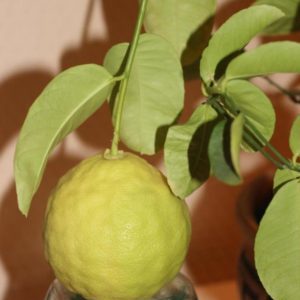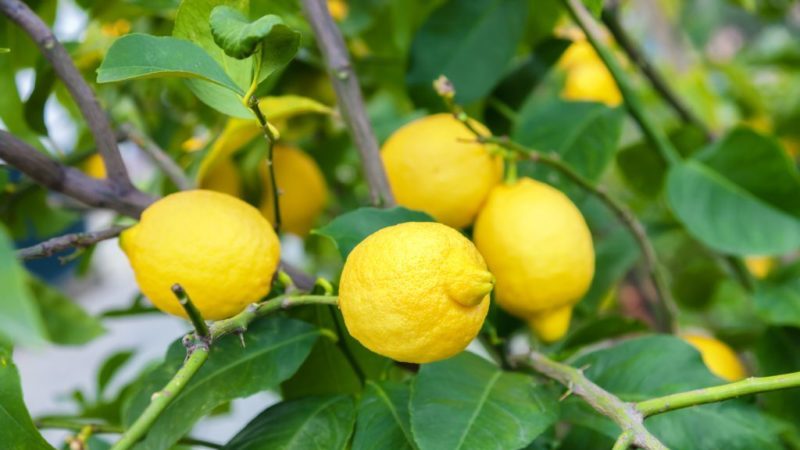An unpretentious lemon variety Jubilee for beginner flower growers
Growing lemons at home is consistently popular with flower growers. Often everything starts with an ordinary bone from which a wild game grows. After a successful first experience, many people want to try to grow a varietal lemon, which will give large tasty fruits.
As the first cultivated lemon, the Yubileiny variety will be an ideal option. It is distinguished by early fruiting, large fruits, high productivity and resistance to many negative factors that are detrimental to other citrus fruits. It is relatively easy to care for him, however, there are also nuances and peculiarities here.
The content of the article
What kind of lemon is it

The Yubileiny variety is an achievement of Soviet breeders. It was eaten by the Uzbek agronomist Zainiddin Fakhrutdinov back in the days of the USSR.
The history of the origin of the variety is very unusual. On a tree bred by crossing Tashkent and Novogruzinsky lemon, one of the branches began to give large, bumpy lemons and had oversized leaves. From the cuttings taken from this branch, trees were obtained that preserved its characteristics.
Interestingly, the characteristics of the Jubilee lemon are similar to the description of the Panderosa lemon. It is still debated whether Jubilee can be considered a real variety or is it just a clone of an American citrus plant.
Main characteristics
Lemon Jubilee often grow at home. It is to him that it is recommended to pay attention to novice citrus growers. This variety has excellent characteristics with unpretentious care.
Description of Lemon Jubilee:
- Crown. The plant is relatively short, up to 1.5 m high. The crown is not spreading, it lends itself well to formation. The branches are strong and firm, but flexible. Covered with a large number of large and small spines. The crown is thick.

- Leaves. Large, oval, bright green, with smooth edges. The texture is dense, gloss is present. The leaf blade sits firmly on short petioles. There is a rich citrus aroma.
- Bloom. Abundant. Almost every leaf has flowers. This often interferes with the development of the crown. The inflorescences are white on the inside, there are blotches of pale pink outside. Bisexual. Not pollinated by other varieties, but easily pollinated.
- Fruiting. Earlier. The plant is able to bear fruit within 2 months after planting. The fruits ripen uncommonly.
- Fruit. Large, pale yellow. The weight of one fruit varies between 200-800 g. The rind is thick, with pronounced tuberosity. Lemon has a sour taste without bitterness. The aroma is intense.
- Transportability. High. Thick skin protects against damage in transit.
Resistance to negative factors
Growing a Jubilee lemon will be easy even for novice gardeners. This is due to the fact that the variety has resistance to some unfavorable factors:
- Drought. Lemon tolerates low air humidity well, but you should not forget about watering.
- Tolerance for lack of lighting. Unlike other lemons, Yubileiny does not turn yellow and leaves do not fall off when there is a lack of lighting, but they become much larger. Thus, the plant compensates for the lack of light.
- No need for rest in winter. Jubilee will feel good even if the room temperature is not lowered in winter. He does not need a state of rest.
Lemon has no pronounced immunity to diseases, but with proper care it rarely gets sick.
Growing in natural environment and at home
Jubilee in the open field reaches a height of 1.5 m. These are not the highest numbers for lemons. Therefore, the variety is considered undersized.
At home, the plant rarely grows even up to 1 m. At the same time, it has a dense, but not spreading crown.
The tree is quite cold-resistant and can grow outdoors in the Caucasus and Abkhazia. It can withstand short-term cold snaps down to -10 ° C.
At home, he is picky about soil temperature. We have to create thermal insulation for the pot.
Jubilee in a pot bears fruit no less abundantly than in the open field. This is what makes it different from many other varieties.
Advantages and disadvantages of the variety
Jubilee has a lot of positive reviews. This is due to a number of its advantages:
- resistance to dry air;
- large-fruited;

- ease of formation;
- immunity to lack of lighting;
- the ability to bear fruit as early as 2 years after planting;
- ease of rooting;
- not pollinated by other varieties;
- bisexual flowers;
- good fruit taste.
This variety also has disadvantages:
- the need to control the number of inflorescences;
- exactingness to soil temperature;
- lack of immunity to fungal and viral diseases.
Reproduction and planting of Jubilee
Despite the fact that in the fruits of the Jubilee have bones, a generative breeding method will not work. From its seeds a wild grows up without varietal characteristics.
Most often Jubilee propagated by cuttings. Cuttings root quickly if technology is followed.
Planting material is cut from a tree that has already borne fruit. A healthy one year old branch is selected. 8-15 cm recede from its end and cut off. At least 3 buds should remain on the pruning. The place of the cut on the mother plant is covered with garden pitch.
Leaves are cut off from the cutting, except for those that remain at the top. Then it is soaked in a light pink solution of potassium permanganate. This procedure will help to avoid contamination of the rooted plant. After disinfection, the growth of planting material is stimulated by soaking it for 6-12 hours in Kornevin.
After the planting material is prepared, they begin to prepare containers and soil. For lemon, choose a loose, fertile, but not peaty soil.
They buy a special mixture for citrus fruits or prepare the soil themselves. To do this, take in equal proportions sand, black soil and humus. A glass of ash is added to a bucket of soil mixture.
Important! The Jubilee stalk cannot be rooted in water.
Any container with a volume of 0.2-0.5 liters with drainage holes in the bottom is suitable for rooting the cutting. It is convenient to use a cut bottle, the upper part of which will act as a greenhouse, and the lower one in the form of a pot.
You will also need drainage. As a rule, they use shell rock, broken brick, expanded clay or fine gravel.
Containers, drainage and soil are disinfected. To do this, use a dark pink solution of potassium permanganate or a product made from 1 tbsp. l of copper sulfate and 10 l of water.
After completing the preparatory work, they begin planting:
- A drainage layer is poured onto the bottom of the container, the rest of the volume is filled with soil. The soil is watered with water at room temperature.
- The upper leaves on the handle are cut by ½. This is to reduce moisture evaporation.
- The branch is rooted by sticking 3 cm into the ground. It is watered with water or "Heteroauxin".
- The container with the seedling is covered with a cut off part of the bottle or a bag.
- The plant is ventilated daily for 15 minutes. To do this, remove the package or unscrew the cap on the bottle.
- Water the seedling every day. The branch is additionally sprayed with warm water.
Lemon rooting occurs about a month after planting.The emerging shoots will testify to this. When the plant takes root, the duration of airing begins to increase. After a week, the greenhouse is removed.
A seedling is transplanted into a new container when its roots fill the old one.
Growing technology
Jubilee is considered unpretentious to care for, but it still has some features. They must be taken into account when growing a houseplant. If not properly cared for, it will hurt and be attacked by pests.
Optimal conditions
For a lemon to grow quickly and develop correctly, it is important to provide optimal growth conditions.
The Jubilee requirements are not very different from other varieties:
- Humidity. Jubilee is able to tolerate dry air, but it is recommended to maintain humidity in the room at least 70%. During the warmer months, the tree is sprayed with warm water in the morning or evening every day. In winter, if the tree hibernates in a heated room, it is also sprayed. Additionally, containers with water or a humidifier are placed nearby.
- Lighting. A pot of lemon tree is placed on the east or west windowsill. Here, the lighting is optimal around the clock. If the lemon is on the south window, then it will have to be removed into the shade when the sun is most active. Lemon will feel uncomfortable on the northern windowsill. In winter, especially if the lemon is dormant, no additional lighting is needed. Phytolamps are needed if the grower wants the plant to develop even in the cold season.
- Temperature. The optimum temperature range for Jubilee varies between 18-26 ° C. During the flowering period, it is not recommended to increase the values above 21 ° C, otherwise few fruits will be set.
To keep the tree at rest in winter, the temperature is lowered to 10-14 ° C. In the case of Yubileiny, this is not necessary.
Note! Lemons that are dormant in winter are believed to develop faster and produce more fruit during the warmer months.
Care rules

If you regularly look after lemon of this variety, there will be no problems with it.
The list contains basic rules and features:
- Watering. Lemon is watered with warm water without chlorine as the soil dries. In the hot summer, this is done every day, the rest of the time every other day. In winter, if the tree is dormant, the frequency of watering is reduced to 1 time per week. The soil is moistened in the morning or evening.
- Warming the pot. Jubilee is picky about soil temperature. So that it does not overheat in summer and does not overcool in winter, it is wrapped in insulation or knitted fabric. This is especially true if the lemon is taken out in the garden in the summer.
- Loosening. After each watering, the soil is loosened. This is necessary to break down the earth crust, which prevents air from reaching the roots, contributing to the development of root rot.
- Top dressing. Lemon has large fruits. Often inflorescences and fruits are simultaneously present on the plant. He needs frequent feeding. Fertilizers are applied once a week, alternating mineral and organic compounds.
- Transfer. Up to 3 years, lemon is handled annually. It is taken out of the container along with a lump of earth. Only the top layer of soil (2 cm) and drainage are removed. Drainage is poured into a larger pot and a tree with a clod of earth is placed. The free space is covered with soil, which is tamped. The plant is watered.
- Transplants. The plant is transplanted once every 2-3 years, when it begins to bear fruit. To do this, before the procedure, the soil is watered abundantly. The tree is taken out with a fork. Most of the land is thrown away. Tear off all rotten and dry roots. Drainage and a little soil are poured into a new, larger pot. The lemon is transplanted by gently straightening the root system and not deepening the root collar.
- Replacement of soil. When the lemon reaches the maximum desired size, the transplants are stopped. Now only the upper part of the soil is removed.The lemon is washed in the shower until clear water flows from the drainage holes. Then, instead of the old soil, new soil is poured.
- Bloom. The lemon tree blooms several times a year. If it bloomed 1 or 2 g after planting, then the inflorescences are cut off. Further, with too abundant flowering, part of the inflorescences is cut off so that they do not interfere with the development of shoots and fruits.
- Fruiting. The fruits are cut off if they appeared on the tree earlier than 3 g after planting.
- Cleaning. Every week, the leaves are wiped with a damp cloth. For the prevention of diseases and pests, the tree is washed under the shower every week, covering the soil with a plastic bag.
- Formation. When the plant reaches a height of 30 cm, pinch the top point of growth. All shoots are shortened to 15 cm.
- Sanitary pruning. In autumn, all dry and weak branches are removed from the lemon.
Possible problems and methods of solving them
At home, the lemon tree is rarely affected by diseases and pests. However, with improper care, this is possible, as well as the occurrence of a number of other problems.
The most common ones are presented in the list:
- Chlorosis. The leaves become pale, the still bright veins stand out well against their background. Over time, the greens fall off. The disease overcomes lemons with an excess of chlorine. To solve the problem, they bring feeding with iron.
- Spider mite... More often than other plants, it starts at home with low humidity. Drinks juices from the plant, leading to death. It is recognized by the cobweb on the original side of the sheet plate. To eliminate the pest, the tree is washed under the shower, and then sprayed with soapy water or insecticide.
- The plant does not bloom. Nutritional deficiencies or malformations may be to blame. One way to make lemon bloom is to eliminate the negative factors listed above and arrange a cold winter.
Harvesting and application of the crop
When the fruits turn yellow, they are ready to harvest. However, fruits with a green crust also have benefits and taste. In this case, they taste more sour.
The fruits are eaten both fresh and as an additive for second and first courses, desserts and drinks.
Conclusion
Lemon Jubilee is one of the most unpretentious representatives of citrus fruits. It easily tolerates cold snaps, lack of light, dry air and the absence of cold wintering. This plant will generously forgive the novice gardener for his mistakes.
Despite its unpretentiousness, the variety is distinguished by its large and aromatic fruits. In a pot, it bears fruit no less abundantly than in the open field. This is its main advantage.